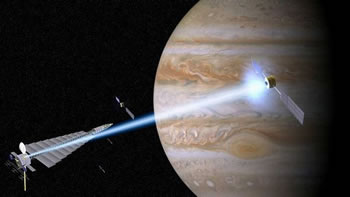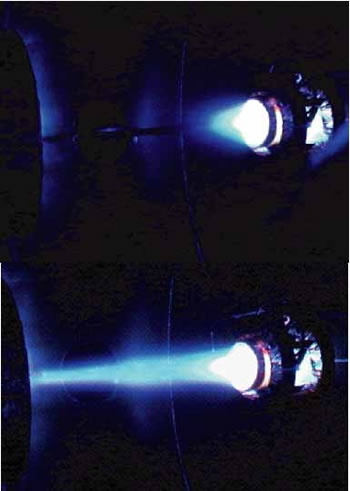Science Fiction
Dictionary
A B C D E F G H I J K L M N O P Q R S T U V W X Y Z
MagBeam Propulsion - To Mars And Back In 90 Days

Magnetized-beam plasma propulsion, or magbeam propulsion, could cut the time required for long journeys around the solar system from years to weeks.

(From Mag-beam propulsion)
The MagBeam propulsion system is being developed at the University of Washington; earth and space sciences professor Robert Winglee is leading the project.
"We're trying to get to Mars and back in 90 days," Winglee said. "Our philosophy is that, if it's going to take two-and-a-half years, the chances of a successful mission are pretty low."People usually think of a spacecraft as a ship with both payload and power source. The MagBeam system separates these two logical units; the power source stays in one place (for example, in permanent orbit around the Earth). Spacecraft are pushed to other parts of the solar system.
Advantages of MagBeam Propulsion
MagBeam propulsion offers significant advantages over conventional rockets:- One power source could be used to power multiple craft (serially, not at the same time).
- The power source could use solar energy, resulting in additional cost savings.
- Plasma propellants are accelerated to speeds an order of magnitude greater than those achieved by chemical rocket propellants, resulting in higher spacecraft velocities - at least 26,000 miles per hour.
- A round trip to Mars would take 2 1/2 years using current technology. If the trip time could be shortened, many other difficulties (like the quantity of consumables and the psychological effects on the astronauts) could be greatly eased.
How MagBeam Propulsion Works
The system requires a power source at each end of a journey; one to accelerate the spacecraft at the start and another at the destination, to decelerate it. The spacecraft simply coasts during the journey from planet to planet. Once MagBeam power sources are placed at destinations around the solar system, the system can be operated using solar power alone.MagBeam depends upon a highly collimated plasma beam. The high power helicon (HPH) under development at the University of Washington is a state-of-the-art electrodeless plasma thruster, which allows high power levels to be generated over long periods of time with little erosion of the system. The plasma is generated by high power radio frequency waves; as a result, HPH is substantially smaller than other plasma thrusters.

(From High Power Helicon)
The spacecraft will need to have a deflector system to accept the energy from the HPH. This can be achieved by plasma magnet systems; plasma effects are used to make an initially large magnetic deflector. The system is self-focussing. Click to see a video showing deflection and self-focussing.

(From MagBeam Deflector System)
So when can we expect a MagBeam test mission? According to Dr. Winglee, within 5 years if funding remains consistent. Residents of Seattle can attend the NASA Advanced Concepts Institute meeting early this week to learn more.
The idea of separating the spacecraft and its payload from its power source was first explored in science fiction in the excellent 1974 novel Mote in God's Eye, by Larry Niven and Jerry Pournelle. In the book, a battery of laser cannon were used to accelerate a small ship with a light sail to a significant fraction of the speed of light. The original idea for a laser-based propulsion system is credited to Robert L. Forward and dates from 1961. You may also enjoy this article on Solar Windsurfing; it provides an interesting precursor to the idea of laser cannon.
See the original article New propulsion concept could make 90-day Mars round trip possible.
Scroll down for more stories in the same category. (Story submitted 10/16/2004)
Follow this kind of news @Technovelgy.| Email | RSS | Blog It | Stumble | del.icio.us | Digg | Reddit |
Would
you like to contribute a story tip?
It's easy:
Get the URL of the story, and the related sf author, and add
it here.
Comment/Join discussion ( 29 )
Related News Stories - (" Space Tech ")
Will Space Stations Have Large Interior Spaces Again?
'They filed clumsily into the battleroom, like children in a swimming pool for the first time, clinging to the handholds along the side.' - Orson Scott Card, 1985.
Reflect Orbital Offers 'Sunlight on Demand' And Light Pollution
'I don't have to tell you about the seven two-mile-diameter orbital mirrors...'
Chrysalis Generation Ship to Alpha Centauri
'This was their world, their planet ó
this swift-traveling, yet seemingly moveless vessel.' - Nat Schachner, 1934
The First Space Warship For Space Force
'Each of the electrical ships carried about twenty men...' - Garrett P. Serviss, 1898.
Technovelgy (that's tech-novel-gee!) is devoted to the creative science inventions and ideas of sf authors. Look for the Invention Category that interests you, the Glossary, the Invention Timeline, or see what's New.
Science Fiction
Timeline
1600-1899
1900-1939
1940's 1950's
1960's 1970's
1980's 1990's
2000's 2010's
Current News
Boring Company Vegas Loop Like Asimov Said
'There was a wall ahead... It was riddled with holes that were the mouths of tunnels.'
Rigid Metallic Clothing From Science Fiction To You
'...support the interior human structure against Jupiterís pull.'
Is The Seattle Ultrasonics C-200 A Heinlein Vibroblade?
'It ain't a vibroblade. It's steel. Messy.'
Roborock Saros Z70 Is A Robot Vacuum With An Arm
'Anything larger than a BB shot it picked up and placed in a tray...'
A Beautiful Visualization Of Compact Food
'The German chemists have discovered how to supply the needed elements in compact, undiluted form...'
Bone-Building Drug Evenity Approved
'Compounds devised by the biochemists for the rapid building of bone...'
Secret Kill Switch Found In Yutong Buses
'The car faltered as the external command came to brake...'
Inmotion Electric Unicycle In Combat
'It is about the size and shape of a kitchen stool, gyro-stabilized...'
Grok Scores Best In Psychological Tests
'Try to find out how he ticks...'
PaXini Supersensitive Robot Fingers
'My fingers are not that sensitive...'
Congress Considers Automatic Emergency Braking, One Hundred Years Too Late
'The greatest problem of all was the elimination of the human element of braking together with its inevitable time lag.'
The Desert Ship Sailed In Imagination
'Across the ancient sea floor a dozen tall, blue-sailed Martian sand ships floated, like blue smoke.'
The Zapata Air Scooter Would Be Great In A Science Fiction Story
'Betty's slapdash style.'
Thermostabilized Wet Meat Product (NASA Prototype)
There are no orbiting Michelin stars. Yet.
Could Crystal Batteries Generate Power For Centuries?
'Power could be compressed thus into an inch-square cube of what looked like blue-white ice'
India Ponders Always-On Smartphone Location Tracking
'It is necessary... for your own protection.'
